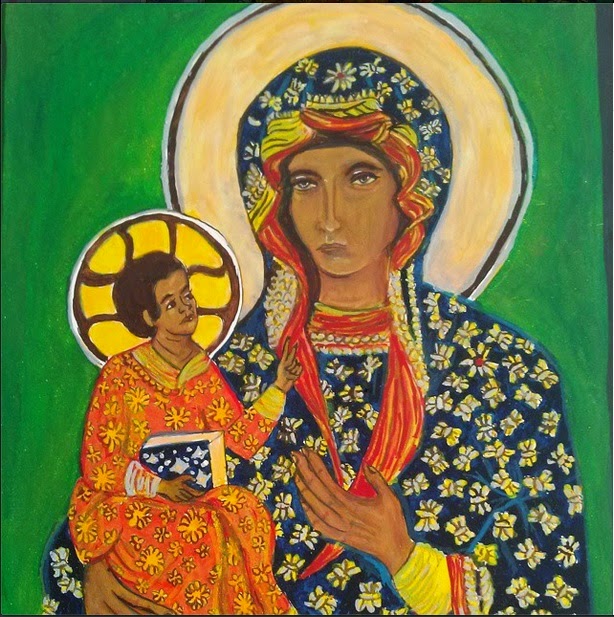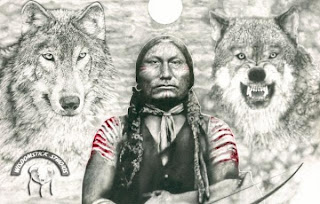My rendition of the Black Madonna
Images of the "Dark Virgin" or the "Black Mother of God"or the "Black Virgin"or the "Dark Madonna" are scattered across Europe from Poland through former Yugoslavia, parts of the former Soviet Union, in France, Germany, Spain and Italy. Some estimate that over 400 representations of the dark virgin in the form of statues, sculptures or paintings, exit across Europe. Many are believed to be located along the Camino de Santiago (or the Way of St James), one of the oldest pilgrimage routes in Europe. More recent depictions of the Black Madonna are venerated at Gaudalupe in Mexico.
Legend suggests that the Black Madonna is the Christianised version of the tribal goddesses of old Europe. Surviving images date back to medieval times. Some Jungian analysts suggest that she is the archetype of the Dark Mother, the symbol of our inner shadow-self when properly integrated into the collective psyche. In this form, she, being black, in predominantly white Europe, is seen to be the friend of the oppressed, and a reconciling force among different races. She is also a guide and comforting companion at the hour of death taking on the sins of the faithful as they stand before the throne of judgement.
Black Madonna images are of different types. Some have pitch black skin and multi-hued clothing, others are made of blackened wood or metal, still others are darkened by the normal aging process that occurs in all antique art and furniture.
Many of these images were believed to be unearthed near springs or in trees - power spots which dated back to Pagan Europe and were traditionally associated with the thinning of the veil between the material and the divine. These images were rumoured to have appeared miraculously when a community was in need of healing, suggesting that the Black Madonnas were sometimes emblems for grass roots movements among rural people. During the Middle Ages, relics were sometimes incorporated into the clothes and regalia of the Black Madonna figures.
The figures appear aloof, almost queenly, unlike later images of Mary which appear tender and compassionate. They were intended to portray heavenly majesty which was above the realm of strife and suffering. Their robes were originally white, red and blue with gold ornamentation (colours associated with alchemy and meant to depict the transformational power of knowledge and wisdom), but the colour could have been changed during restorations.
From an alchemical perspective, the Black Madonnas represented three phases of transformation:
1. The Blackening, or the Black Sun (nigredo, sol niger) referred to the phase when all impurities in human being are burned or rotted away. Blackness representing the destruction and falling away of the false self. In Black Madonnas this was represented not only by her black skin but also by her dark blue robes reminiscent of the night sky.
2. The Whitening (albedo) referred to the phase in which the soul becomes spiritualized and enlightened.
3. The Reddening (rubedo) represented the color of a "secret fire" that unites human and divine, the limited with the unlimited.
After having passed through these
three stages, lead would turn into gold and a human into God. For Catholics, Mother Mary, is
the prime human soul to have undergone this transformation. To represent this, the is adorned with
golden fringes and jewelry. In keeping with this symbolism, Black Madonnas are traditionally portrayed in dark blue, red,
and white, and decorated with gold, portraying the entire process of spiritual
evolution.
Additionally, Black Madonna statues and images were usually 70 centimeters in height, 30 cm in width, and 30 cm in depth, with
slight deviations due to pedestals and head dresses. This 7:3 proportion echoes sacred numerology that goes back to
pre-Christian times. In the Christian context it speaks of the union of God
(the three persons of the Trinity) and His creation (completed in seven days). Interestingly, no other
Christian statues shared such a rule concerning their dimensions. Romanesque
depictions of Christ and various saints came in different sizes. In contrast, the
Queen of Heaven with her 7:3 ratio may embody the divine and its creation.
The pattern of colouring and intensity of colour differs in different images of the Black Madonnas. Some were clearly crafted to depict a pitch black mother and child. Some show a black mother and white child, yet others are Byzantine icons with dark complexions consistent with the skin colour of Palestinian Jews of the first century. Some statues are dark because of the material they were crafted out of - dark wood or metal.
The version of the Black Madonna which I chose to write as an icon, was the Black Madonna of Czestochowa in Poland. Tradition has it that the image was painted by St Luke on the kitchen table of the Holy Family which was incidentally made by Jesus. Mary was believed to be the actual model for the image. After the destruction of Jerusalem in 70 C.E. the image was hidden to safeguard it and it emerged only in 326 C.E. when it was rediscovered by St Helena, mother of Emperor Constanine. She had a church built to house it in Constantinople, where it was venerated until the iconoclasms of the the 8th century. What happened to the icon following this period is uncertain but it is thought to have found its way to the forest of Belsk in Poland where the Prince of Belsk was instructed in a dream to take the icon to Czestochowa and hand it over to the monks of St Paul of the Desert for safekeeping.
On Easter Sunday 1430, a band of thieves associated with the Protestant Hussite movement entered the monastery to steal its treasure, found nothing and so attempted to steal the icon. Again, legend has it that the robbers' horses refused to move due to the intervention of the Divine Mother. This infuriated the theives and they vented their anger on the icon, slashing the face with a saber, throwing it to the ground and breaking it in half. The monks recovered the icon pieces on the outskirts of the town, where a spring miraculously appeared. Monastery artists tried to restore the icon and repair the damage to its face, but did not succeed. After several attempts at restoration by experts from different parts of Europe, there was a general consensus that perhaps the Mother of God, required that the scars be retained as a symbol of her compassion for her people.
In time, the Black Madonna of Czestochowa became a symbol of Polish identity and independence.
My icon of the Black Madonna:
After tracing the image of the icon onto the tempera board, it became clear that what I had traced was a mirror image of the original. Faced with the dilemma of whether to erase it and start from scratch or to proceed, I decided to take the latter course of action. As my icon is not a "true" copy of the original, I decided to allow myself some creative license and let the image "flow" as I proceeded to write/paint it. As a result, the borders, ornamentation are different from the original and there is no gilding.



Comments
Post a Comment